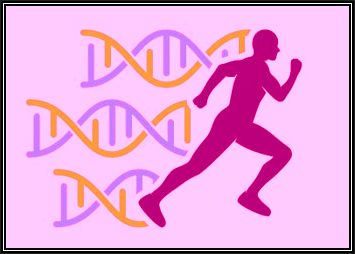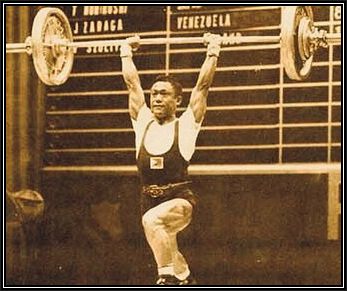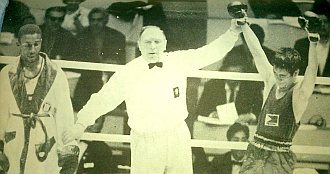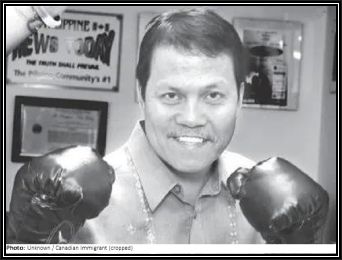
|
Philippines, 16 Dec 2025 |
Home >> News |
 |
||||
|
|
|
|
IN THE GENES By Red Dumuk PhilBoxing.com Sat, 23 Mar 2024  “Champions are made, not born.” This is a common mantra of coaches, especially the more demanding ones. Muhammad Ali, arguably the greatest heavyweight of all time, qualifies the above credo, thus: “Champions aren't made in gyms. Champions are made from something they have deep inside them—a desire, a dream, a vision. They have to have the skill and the will. But the will must be stronger than the skill.” The second sentence, often attributed to Mahatma Gandhi, opens the door for the role of genetics. This is best exemplified by some Filipino athletes in the apex of the Olympic movement—the Olympic Games which celebrate the first year of an Olympiad, a period of four years. Case Study: Genetic Influence PHI's first medal winner and double medalist (bronze, Amsterdam 1928 and bronze, Los Angeles 1932) had a descendant who competed in swimming at the Beijing 2008 Games: great-grandson Daniel Coakley. In Los Angeles 1932, the tenth Olympiad, brothers Jose Jr. and Carlos Padilla competed in the lightweight and welterweight classes, respectively. Jose Jr. also competed in Berlin 1936. They were both sons of Bulacan Governor Jose Padilla, who also served as Congressman. Jose was the grandfather of Senator Robin Padilla, who once chaired the Muaythai Association of the Philippines. Carlos was the father of Carlos "Sonny" Padilla Jr., a boxing referee and judge, best remembered for officiating the legendary "Thrilla in Manila" fight between Muhammad Ali and Joe Frazier in 1975. Carlos Jr. was inducted into the Nevada Boxing Hall of Fame in 2022 after a distinguished 33-year career as a referee/judge. Another featherweight boxer, Felipe Gabuco, was one of PHI’s pugilists in Berlin 1936, was the great grandfather of Josie Gabuco, first PHI’s amateur boxing world champion (2012). Also an Asian champion (2019), she owns the most number of Southeast Asian Games boxing medals among women—five, (2009, 2011, 2013, 2015 and 2019). Jack Ciria Cruz, who was a member of the first PHI basketball squad to the Games (Berlin 1936), was an uncle of brothers Felicisimo “Fely” and Gabby Fajardo who played for the PHI basketball team that became the first to score 100 points in a match at the Olympics (PHI pummeled Iran, 102-30). This was in London 1948, first Games after WWII; PHI was edged by Belgium, 34-38 in the 11th place match. Fely coached the PHI quintet to Helsinki 1952 where PHI ended up tied 9th-16th. Rodrigo del Rosario represented the PHI in featherweight weightlifting in London 1948, Helsinki 1952 and Melbourne 1956. At his first Games he placed fifth in a field of twenty-three competitors. Del Rosario’s best outing was in 1952. He was barely eased out of the podium among the twenty-two bets. However, he set a world (and Olympic) record in the military press and became the first Filipino to set an Olympic record. In 1956, he bombed out in the clean & jerk. 
Salvador del Rosario. His nephew, Salvador followed in Rodrigo’s footsteps—three-time Olympian. He competed as bantamweight in Mexico 1968 and as flyweight in Munich 1972 and Montreal 1976. As flyweight, he was the first Filipino to stash a gold medal in Worlds of an Olympic sport--in the 1970 World Weightlifting Championship. Rodrigo’s son was a double Olympic veteran. He lifted as bantamweight along with his cousin Salvador in Munich 1972 and Montreal 1976. London 1948 also saw breaststroker Jack Cayco, who would become PSHOFer in 2021 as Asian Games double gold medalist, showing his wares. His brother, Pedro, swam at the Melbourne 1956 also as breaststroker. Two years later, Pedro claimed a silver in the 1958 Asian Games. Mariano Tolentino, a PHI quintet to Helsinki 1952 player who would become 1954 FIBA Basketball World Cup bronze medalist had a nephew—Benjamin Tolentino--who rowed in the Sydney 2000 single sculls event. Wrestler Gonzalo Manibog who competed in freestyle featherweight class in Helsinki 1952 sired a son, Dean-Carlos who grappled in freestyle lightweight in Seoul 1988. In Melbourne 1956, PHI fielded her very first female athletes—two sprinters and two swimmers. Gertrudes who would be elected to elected to the Philippine Sports Hall of Fame (PSHOF) on account of her five silvers and three bronzes in three Asian Games dove into the water first. In the same Games, her brother Agapito, an Asian Games medalist himself, competed in butterfly events. With Gertrudes in the Melbourne 1956 was Jocelyn von Giese, a backstroker who grabbed two golds in Asian Games. (It was International Olympic Committee member from PHI Jorge Vargas who delivered the winning vote for Melbourne over Buenos Aires for the hosting rights.) Gertrudes, a freestyle and butterfly specialist, took part anew in butterfly alone in Rome 1960 where Sandra von Giese, sister of her erstwhile teammate Jocelyn, became her new teammate. Sandra, also copped a medal each of the three colors in Asian Games. 
Anthony Villanueva (R) won silver medal in the 1964 Tokyo Olympics. PHI secured her first silver medal in Tokyo 1964 through featherweight boxer Anthony Villanueva only after racking five bronzes before World War II yet. Upsetting one of the two pre-competition favorites, from the US, he lost by closest of margin, 2-3 to a Soviet, the other favorite. Bantamweight boxer Jose Luis Villanueva, Anthony’s father, notched in Los Angeles 1932 PHI’s fourth bronze and one of the three in the same Games. The Fortaleza four brothers compose the biggest number of Olympians in one family. Bantamweight Ricardo or Ric, the eldest, saved the PHI from gold-medal shutout in the 1970 Bangkok Asian Games, prior to seeing action in Munich 1972. His brother Rene, a flyweight, also fought in the same Games. Rene went on to serve as referee/judge in Barcelona 1992 where PHI notched her seventh Olympic medal. The Fortalezas were the fourth pair of siblings to participate in the same edition of the Olympics in the same sport. The Padilla brothers own the distinction of being the first—Los Angeles 1932 in boxing. Following them were the Fajardo brothers in London 1948 in basketball. Third were sister-brother tandem of the Lozadas in Melbourne 1956. 
Reynaldo Fortaleza. In Montreal 1976, Reynaldo Fortaleza reached the quarterfinals—one victory away from a bronze. Though he did not graduate to the Olympic level boxing like his three brothers, Rogelio Fortaleza, silver medalist in the 1977 SEA Games and 1979 ASEAN Amateur Boxing Championships, entered Beijing 2008 as referee/judge. (PHI joined USA in boycotting Moscow 1980). He was the first Filipino AIBA 3-star referee-judge and rose to secretary-generalship of the Association of Boxing Alliances in the Philippines. Roel and Mansueto “Onyok” Velasco proved to be foremost of all siblings as they duplicated the Villanueva father-and-son tandem’s feat of jabbing out bronze and silver medals. Onyok in Atlanta 1996 better known as “Centennial Olympics” bettered his older brother’s bronze in Barcelona 1992. They both competed as light flyweights. 
Mansueto 'Onyok' Velasco. Roel earned PHI’s first silver in boxing Worlds (1997) and stood as the only Filipino to win medal in the 1998 Goodwill Games. Before he seized PHI’s 2nd Olympic silver, Onyok was 1994 Asian Games champion. Brothers Isidro and Virgilio Vicera, also took part in boxing battles as flyweight in Barcelona 1992 and bantamweight in Atlanta 1996, respectively. A fifth duo siblings seeing action in same sport of the same Games staging cropped up at the turn of the century. In Sydney 2000, the quest of light flyweight Danilo Lerio and flyweight Arlan Lerio stopped at the round of 16. A trio of Yulo siblings—namely Carlos Edriel, Karl Eldrew and Iza—may shape up similar to the Fortaleza brothers but not in boxing. Carlos, the eldest, is already an Olympian and by himself has propelled PHI to 34th position in the all-time Artistic Gymnastics World Championship medal table. Karl, 15, groomed to be the next Filipino artistic gymnastics star has shown promise with his silver-medal performance in 2023 Asian Artistic Gymnastics Championships. The youngest, 12-year old Iza, made her debut in the same tourney. The big question here is: What kind of genes are active here? In an analysis-article at the nba.com by Shaun Powell and Stuart Hodge entitled Five key reasons Stephen Curry became the greatest NBA shooter of all-time and revolutionized basketball with his shooting, they submit Reasons 1 & 2: His father and the basketball genes and upbringing (underscoring mine). Stephen’s father is Dell Curry, during his 14-year NBA career the most accurate distance shooter. The father was quoted telling his son in the book Heart of a Champion (not the one penned by Frank Deford but by Steve Rialch), “I think you have the gene to shoot, but you also have the gene to work at it. You can have the skill, but if you don’t work at it, it's not going to get better.” Dell has another son, Seth, who is a 3-point shooter for Sacramento Kings. Did the sons of Carlos Loyzaga, all the superlatives vis a vis Philippine basketball could be heaped on him plus FIBA Basketball of Famer and 1954 FIBA Basketball World Cup All-Tournament Team Center (Mythical Five) and two-time Olympian (London 1952 and Melbourne 1956), not fully grasp the essence of aforesaid principle? Ask Chito and Joey—who both carried our tricolors in the Asian Games where their father collected five gold medals. PhilBoxing.com would like to welcome Red Dumuk to its family of worldwide contributors. Click here to view a list of other articles written by Red Dumuk. |
|
|
PhilBoxing.com has been created to support every aspiring Filipino boxer and the Philippine boxing scene in general. Please send comments to feedback@philboxing.com |
PRIVATE POLICY | LEGAL DISCLAIMER
developed and maintained by dong secuya © 2025 philboxing.com. |